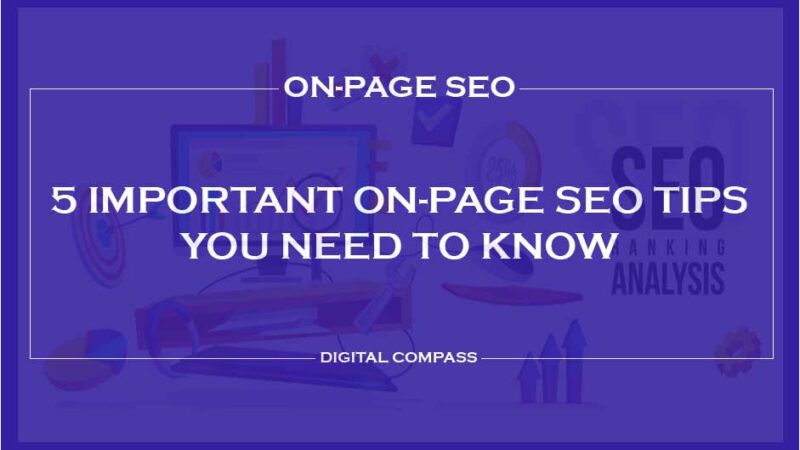SEO for Real Estate Websites

The real estate industry is highly competitive, particularly in major metropolitan areas. The tactics that make your content and website easily available online must be optimized by real estate businesses. These methods, in particular, turn your website into a legitimate and trustworthy real estate website, resulting in more organic client traffic and greater search engine ranks.
One of the most important aspects of real estate digital marketing is SEO. You can rank higher in search engines and generate leads organically by using relevant keywords and up-to-date content. SEO will help you in increasing traffic & conversions, raising brand awareness, increasing domain authority, improving ROI, and many other things.
Here are some of the tips to improve the real estate website.
Start with an SEO Audit
An SEO audit can assist you to figure out which pages are performing effectively and where you can improve. While an audit takes time, it serves as a benchmark for your progress and gives the data you need to establish a strategy.
An SEO audit can help you to determine the following.
- What percentage of your traffic comes from organic sources?
- Are you able to generate leads or convert clients?
- Does your website have a local ranking?
To increase the organic traffic, focus the below key areas.
- XML sitemap, robots.txt, and redirects are all part of the site structure.
- Titles, meta descriptions, header tags, alt tags, and URLs are all part of the page structure.
- Structure, keyword and link placement, graphic components, duplicates, redirects, and canonical tags are all important aspects of content.
- Outbound and incoming links, interlinking with other pages on your site, and broken links are all examples of links.
- Accessibility, smartphone friendliness and site speed are all aspects of usability.
Optimize for search
You can’t buy Google rank with money alone, but with a little effort and planning, you can improve your position on the search engine results page (SERP) without spending a dime. There are several best practices you can use right away to optimize your content for search.
Focus on the below checklist.
- Keyword research & analysis
- Optimize the header tags
- Create SEO friendly URLs
- Optimize images
- Identify the broken links
- Optimize the site speed
- Check schema, robots.txt & xml sitemap
- Optimize content, CTR & bounce rate
Focus on local SEO
A local search strategy’s importance cannot be overstated. Having a local SEO plan is now a need rather than an option for real estate, community businesses, and other organizations trying to take advantage of mobile, as well as new and evolving consumer behaviors.
Customers in various industries – not just retail and eCommerce – are looking for the best products and services available near them. They expect local responses and services as soon as possible. The way you target clients is one of the key differences between local SEO and “normal” SEO. More than 40% of Google queries have a local focus.

Here’s a comprehensive local SEO checklist to assist you.
Local SEO: Website Optimization
Links are attracted to high-quality content. For that, you need a local content strategy. Content and links are the two most important Google ranking factors. Furthermore, for local SEO, relevant/high-authority backlinks are still the most important ranking factors to consider.
- Create a content strategy for your website that is consistent.
- Use localised keywords in title tags and meta descriptions.
- Use semantic variations of local keyword targets to optimise static text and blog content. For example, if your company sells real estate in Mumbai, you’ll want to generate material about what to do near those properties in Mumbai in addition to content about the homes themselves.
- To enrich and supplement the information, including local photographs and videos (optimised with relevant keywords).
- Original content should be published, duplicate listings and content should be removed.
Local SEO: Citations
A local citation is any online mention of a local business’s name, address, and phone number. Citations can be found in local business directories, websites, apps, and social media platforms.
- Citations can be added manually or automatically. Manual citations have the advantage of being controllable, but managing them might be time-consuming if you decide to relocate or rebrand. Automatic citations, on the other hand, save time and work, but they provide you less control over your business listings in the long run.
- For local citations and listings, use a third-party service. BrightLocal, MozLocal, Whitespark, Advice Local, and Yext are among the third-party suppliers.
Local SEO: Customer reviews & social media
Reviews inform other potential consumers about the quality of service they may anticipate from your company, whether it’s good or negative. Google has emphasized that social media interactions (such as likes, shares, and comments) are not taken into account when ranking web pages, although they can help a business’s visibility, which is a local ranking factor.
- For your products and services, take advantage of client testimonials and reviews. Put them up on your site.
- List your company on sites like Yelp, Foursquare, Zagat, Bing Places etc.
- If you haven’t already, add your company to Google My Business. This can have the greatest impact on your SEO because Google reviews are the first reviews people see when they search for your business on Google.
- Choose a business listing management tool to assist you in optimising your local business information on the web. Acxiom My Business Listing Manager and Localhub are two tools for managing business listings.
- Invest in customer review management tools such as BirdEye, ChatMeter, OnDemandReviews, and ReviewTrackers to alert you immediately when a customer review requires further action.
- Determine which social media sites are popular among your customers/clients and target audience.
- Create a profile for your company on each major social media platform like Facebook, LinkedIn, Twitter, Pinterest, and Instagram.
- Localize all of your social media platforms and connect them to your website.
- Incorporate the NAP+W (Name Address Phone + Website) into each social media listing.
- Attempt to get your social media listings verified.
- Share user-generated content on your social media platforms.
- Verify your Google My Business profile and upload photos of your company.
- Encourage customers to leave reviews on your Google My Business listing, but don’t compel or reward them! Too many reviews at once can raise suspicion and result in account suspension.
- Keep track of and analyse your rankings, including organic keyword position.
- Conduct a site audit on a regular basis to look for any red flags.
Competitor research
In the real estate industry, knowing what your competitors are doing—how they think about the market, which techniques they use, how they construct messages and design—can make all the difference.
The scope and budget of any competitive audit can vary greatly depending on a variety of elements such as the company’s type and size, as well as the scope and budget of the project.
However, following the methods outlined below will assist you in conducting a competitive audit that satisfies the real estate industry’s basic standards.

Identify your competitors
If you don’t know who your competitors are, you won’t be able to do a competitive analysis. Make sure you aren’t overlooking any competitors by conducting research. Begin by conducting research into your niche to find key players and businesses.
To achieve this run a Google search, check over the list of possible presenters and companies at your niche conferences, and ask your customers who else they considered.
Categorize your competitors
You’ll want to categorize your competitors as you find them, from direct competitors to those you should keep an eye on, such as indirect and tertiary competitors.
Direct competitors are businesses that provide similar services in the same geographic area as you, targeting the same audience and meeting the same needs.

Companies who provide the same, or comparable, services to you in the same area but serve a different need or purpose or target a different audience are considered indirect competitors.
Tertiary competitors that provide services that are just tangentially related to yours but do not compete.
Identify your competitors’ positioning
Positioning refers to where a company’s services stand in respect to the competition in the marketplace as well as in the minds of customers. You can acquire a sense of your market’s wants and expectations by looking at your competitors’ positioning strategies, especially direct competitors.
Have a look at their website and try to answer the following questions.
- Why are their consumers getting homes from them in the first place? Is it all about the money? Experience?
- How do they set themselves out from the competitors with their services?
- What distinguishes their properties or services?
These questions will assist you in determining who your competitors are speaking with and how they position themselves in the market, as well as how you will compete with them. To gather more information, signup for their newsletter, subscribe to follow their blog, follow them in social media, employ their service and many more.
Identify your competitors’ key messages & identity
You should closely examine are your competitors’ key messages and identities. This will assist you in developing a distinct identity that will help you stand out from your industry competition.
Ask yourself the below questions.
- What is their mission statement and tagline?
- What are their advertising and brand collateral themes?
- What is the tone and volume of their voice?
- What feelings do customers have when they interact with your brand?
- Is their tone and voice consistent?
Examine your competitor’s website
Examine the following items very carefully.
- What are featured on their homepage?
- How detailed are their property and service described?
- What kind of information they have included for property & service and what is missing?
- What technology is used in the real estate industry for their properties page? Do they have virtual tours, for example?
- Throughout the online experience, what are their calls to action?
- Is there a blog on their website? How often do they post?
- Is their website mobile-friendly?
Conduct a social media audit
The use of social media for business purposes is increasing. Many customers use social media and expect brands to be there to help them. Looking at your competitors’ social media accounts can help you get a good idea of how customers feel about their business and see what works well and what doesn’t when it comes to engaging with your own client base.
The use of social media for business purposes is increasing. Many customers use social media and expect brands to be there to help them.

Looking at your competitors’ social media accounts can help you get a good idea of how customers feel about their business and see what works well and what doesn’t when it comes to engaging with your own client base.
Check Google Analytics reports and start using tools like Sprout Social, BuzzSumo, Social Animal etc.
Optimize for mobile devices
More than 50% of the global traffic comes from mobile devices. This means that if you want to keep Google and your potential customers happy, your website must be responsive to smartphones and tablets.
The following are the key areas to concentrate on when it comes to mobile optimization:
- A responsive design automatically adjusts your site to fit the screen of any device, which is critical for usability.
- If visitors have to wait too long for a page to load, they will most likely return to the search results in search of a more user-friendly site.
- As a general rule, keep things as simple as possible.
- The more steps a user must take to achieve their goal, the less likely they are to complete the process completely.
- The Mobile-Friendly Test tool will assist you in determining whether your current site passes the test and will provide you with a list of issues that require your attention.
- Minify your code and optimise your images to make things go faster. Use an emulator to see how your content looks on different devices.
Check and make sure that your website is accessible
Accessibility testing is the process by which a human examines a website to see if it has any accessibility issues.
- Navigating the website using only a keyboard to ensure that all content can be accessed, used, and engaged with by a user who is unable to use a mouse.
- Listening to the website with a screen reader to ensure that text content and controls can be accessed and understood when read aloud.
- Examining embedded media for the presence and accuracy of closed captions, as well as the absence of rapid flashing.
- Using the website on a variety of device sizes and resolutions to ensure that it is as easy to use on a phone as it is on a desktop computer and that it can be used when significantly zoomed in.
Create useful content for your blog
Including a blog on your website expands your opportunities to target relevant keywords. A real estate blog should be a mix of informative articles (walkability, cost of living, social life, restaurants, and schools etc), visual content (images, video tours, virtual tours, live stream videos and infographics) and interview with local business owners.
Conducting interviews with local business owners can be time-consuming, but it will be worthwhile.

These interviews provide a unique perspective on your neighborhood and show potential home buyers how nice it is. These interviews are likely to be shared by business owners on their social media platforms and websites in order to raise awareness and expand your reach. Include geographic keywords in the title, headings and subheadings, meta descriptions, alt text, hashtags, and URLs, among other places.
Create more video content
Content is often the simplest to create, but if you have the resources, you should invest in creating and optimizing video content. It can assist you in differentiating yourself from the competition.
Consider the following types of videos.
- Setting up a YouTube channel and optimising it.
- Upload videos to that channel on a regular basis.
- Upload or share your videos on your website and social media pages.
- Create a larger audience by running live streams on Facebook and YouTube.
In the description, include links to your social media profiles, website, and any related listings.
Try to earn featured snippets
Featured snippets have the potential to change the game. Featured snippets can increase traffic, attract users who are interested in your offers, improve search rankings, increase conversion rates and many more.
Earning them can be difficult, and only a few businesses have them in local search.
Try to earn featured snippets
Featured snippets have the potential to change the game. Featured snippets can increase traffic, attract users who are interested in your offers, improve search rankings, increase conversion rates and many more.
Earning them can be difficult, and only a few businesses have them in local search.
Use structured data markup
Structured data markup, also known as schema, assists Google and other search engines in learning more about the type of content on your page. If you want your site to appear in search results with rich snippets, you should use it wherever possible. A real estate agent, offers, products, places, residence, postal address, search results page, web page, and so on can all benefit real estate enterprises.
After you’ve added schema to your site, use the Structured Data Testing Tool to ensure its accuracy.
Measure the performance
Determine which metrics are most important to your business and track them on a regular basis. There are numerous metrics that can be tracked. Google’s algorithm takes into account over 200 ranking factors. However, it is best to focus on a few at first.
Measure and optimize organic traffic, keyword ranking, CTR, SERP visibility, bounce rate, domain & page authority, backlinks and page speed on a regular basis.

Final thoughts
A successful real estate marketing strategy necessitates a number of components. You begin with the basics, then add some unexpected twists to stand out, and finally include some insider secrets to appeal to both clients and other professionals who can assist you in building a successful operation. The real estate marketing ideas listed above cover a wide range of options for getting started with your local and online marketing strategy right away.
Investing in SEO and employing these strategies may enable you to rank well even against industry giants.






